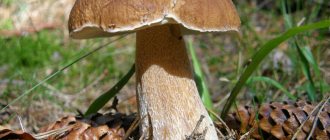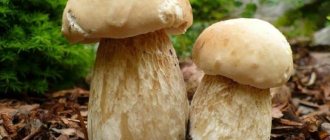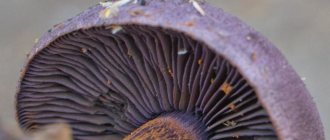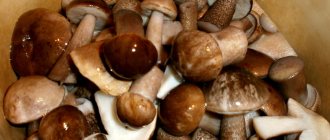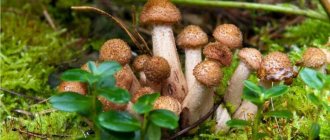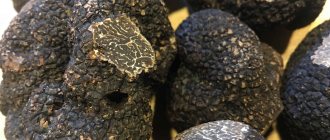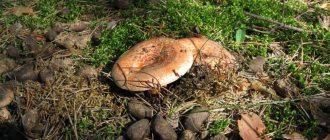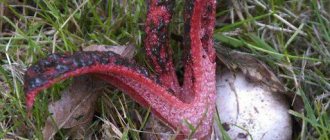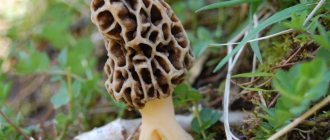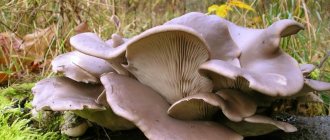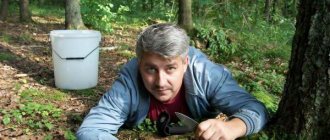The morel cap is an edible, large and fleshy mushroom. The color of this mushroom may vary depending on its age. The name comes from its resemblance to morels, and the small cap on the stem sits loosely. This type of mushroom can be found in mixed and deciduous forests.
Description and Feature
The morel cap has a unique shape and appearance, making it impossible to confuse it with other types of mushrooms.
- small hat It is all covered with vertical folds and wrinkles, literally put on a leg, it can be easily removed without cutting off with a knife. The height of the hat reaches five centimeters and the width up to 4 centimeters. The color depends on the age: in young mushrooms it is brown or chocolate, and in old ones it is yellow-orange. In addition, the color depends on where the mushroom grows.
- The leg is curved, has a smooth surface, its maximum length is 10 centimeters, and its thickness is only 2 centimeters. Often it is flattened on the sides. A young mushroom has a solid stem, but as it ages, a cavity forms and expands. The stem and cap are connected only at the base, and their contact is superficial. The leg has a cream or white color with visible scales; with age it acquires a dark shade.
- Pulp and spores. The flesh of the morel cap is white and thin, resembles cotton wool, has a pleasant mushroom aroma, and the taste is weakly expressed. The spores are smooth and elongated.
The common morel is the only edible morel.
The common morel is a conditionally edible mushroom of the Morel family. In another way, the common morel is called edible morel. Of the morel family, this is the only representative that is suitable for consumption.
The Latin name is Morchella esculenta.
Description of edible morel
The mushroom is hollow inside, so its weight is small. The cap is round in shape, reminiscent of an egg; sometimes there are common morels with spherical or flattened caps.
The color of the cap varies significantly depending on various external factors, for example, the age of the mushrooms or where they grow. The longer edible morels grow, the darker they become.
The cap of the common morel has a rather specific structure: the surface is uneven, wrinkled, with dimples. The pits can be of different sizes; they are lined by the hymenium. The cells are irregular, slightly round in shape. In addition to the cells, the mushroom has light ribs, which are quite narrow in shape.
The leg is shaped like a cylinder; there is a thickening at its base. The leg breaks easily. The pulp of the mushroom is very fragile, tender and crumbles easily. The color of the pulp is light, close to ocher. Over time, the leg becomes darker. The pulp does not have a pronounced mushroom smell, but it tastes pleasant.
Places where common morels grow
Edible morels prefer warm and bright places. These mushrooms grow in soils saturated with lime. Alder, birch, ash and oak forests are excellent for them; in addition, they grow in forests mixed with pine needles.
It is not easy to notice the common morel among the fallen leaves, since its camouflage colors allow it to remain invisible. Most often, these mushrooms grow alone.
Where and when are edible morels collected?
Common morels are quite rare mushrooms, although among other morels they are the most common. They are collected on lawns and forest edges with grass cover. In the south of Russia they can be found directly in the garden or vegetable garden.
You can go looking for morels as early as the end of April, but early morels are more watery and have an indefinite smell. In May they become stronger and acquire a real mushroom aroma with a light fruity note. In the middle zone, there are much fewer April morels than May ones. Individual specimens can be found even at the beginning of June.
Edible morels also appear in parks and gardens of large cities. These mushrooms even grow in Australia. In the USA they are expensive, there is even a Morel Lovers Society, whose representatives call morels “the king of mushrooms.”
How dangerous can morels be?
Morels, like string mushrooms, contain a dangerous substance called gyromitrin. But there is much more of this substance in the lines than in morels or morel caps. Some researchers believe that many areas grow morels that do not contain the toxin.
In any case, it is recommended to first scald, or better yet, boil the morels, then drain the water. In this case, the mushroom will delight you with its taste and will not cause any harm.
Dangerous similarity, or how to distinguish an edible morel from a stitch?
Some mushroom pickers confuse common morels with their poisonous counterparts
Indeed, related species are very similar, but they can be distinguished due to their shape; it is worth paying attention to the fact that the cap of the edible morel is round, in addition, its size is larger than that of poisonous species
In the morel, the length of the cap and stem are almost the same, but in the morel, the stem is often shortened, sometimes it is completely invisible.
Morels have both a cap and a stem that are hollow inside, and the lines are filled with twisted pulp. On the surface of the morel there are sinuous cells.
Edibility of common morels
In our country, these mushrooms are allowed for harvesting. These are conditionally edible mushrooms; they must first be boiled. Morels can also be dried.
We treat these mushrooms with caution, since from time to time information appears about cases of morel poisoning.
But this is due to improper preparation of mushrooms or the fact that poisonous strings are often sold in markets instead of morels.
Edible morels in any form are a great delicacy.
Where and when do morel caps grow?
This mushroom can be found on flooded soil with a temperate climate in the northern zone. These mushrooms grow in moist soil exclusively in spring. On dry soil, the morel cap will not survive, it will dry out and die. You can find this mushroom near:
- stream;
- body of water
- ditch filled with water.
As for the forest, this type of mushroom can be found in:
- birch;
- fake;
- aspen forests.
Most often they grow in large groups and cannot be found individually. Distribution - from the northern Caucasus to Karelia. In Russia, morel mushrooms are collected in the same way as champignons or boletus mushrooms; Russians love them.
Mushroom pickers should go to the forest for mushrooms and look for:
- linden;
- aspen;
- birch;
- poplar;
- alder.
It is near trees that have lived for at least 30 years that mushrooms grow, and near young trees they are much less common.
As for the soil, they do not grow anywhere, but choose only sandy loam soils that are covered with leaves and black soil. During dryness, cold weather and excess moisture, mushrooms die. In the northern parts, rotten mushroom can be seen very rarely.
What can you cook from them?
After preliminary heat treatment, the morel cap can be prepared in any way: pickle, salt, fry, stew. This mushroom is good in fillings, with potatoes, and as an independent dish.
If the raw mushroom is well dried, then after a month you can cook soup from it. Dried mushrooms can be chopped and sprinkled onto soups, omelettes, and gravies. Many mushroom pickers recommend drying members of the morel family for winter consumption.
To prepare the caps, you can use the same recipes as for morels.
How to cook
Before boiling, caps brought from the forest should be soaked in salt water to remove debris and dirt. Then rinse well. The following ingredients should be used for boiling:
- morel caps - 1 kg;
- salt - 3 teaspoons:
- bay leaf - 6 pieces;
- black pepper - 30 peas.
Throw salt, spices, mushrooms into the water, bring to a boil and cook for 10-15 minutes. Pour out the broth.
- cheese (hard) - 100 g;
- butter - 3-4 table. spoons;
- sour cream - 500 g;
- flour - 2 table. spoons;
- eggs - 2 pcs.;
- ground pepper - to taste.
Chop the mushrooms and lightly fry in butter in a frying pan. Add salt, pepper, sprinkle with flour and fry, stirring for another two minutes. Pour in sour cream and simmer for another five minutes. Beat in the egg and sprinkle with grated cheese. In this case, the mushrooms should be continuously stirred. Then they are placed from the frying pan into a mold and baked in the oven until golden brown.
Video: how to make a morel cap
How to pickle
You can try to pickle morel caps using a hot method in the same way as morels.
- morel caps - 1 kg;
- salt - 50 g;
- spices - cloves, peppercorns, dry dill, several black currant leaves.
Soak the mushrooms in salted water, rinse and boil in plenty of water for 10-15 minutes. Place on a sieve. Place in a saucepan, add ½ cup of water and salt, stir. Bring to a boil and add spices. Cook for 20 minutes, stirring constantly. The finished mushrooms should settle to the bottom and the brine should become transparent. After cooling completely, transfer the mushrooms into prepared glass jars and store in the basement. It will be possible to eat such pickling in 1.5-2 months.
How to marinate
Pickling is a more preferable option for harvesting spring mushrooms than pickling.
- morel caps - 1 kg;
- salt - 1 teaspoon;
- vinegar 6% - 3 table. spoons;
- sugar - 1 table. spoon;
- citric acid - 1/3 teaspoon;
- bay leaf - 6 pieces;
- black pepper - 20 peas;
- cloves - to taste;
- cinnamon - to taste.
Soak the mushrooms, wash and cook for 10 minutes in salted water. Cook the marinade: add salt, sugar, citric acid and herbs to a saucepan with 1/2 liter of water. Boil and cook until salt and sugar dissolve. At the end, add vinegar and pour hot marinade over the caps placed in prepared jars. Cover with a nylon lid and store in a cool place (refrigerator, cellar).
Morel cap is a rather tasty mushroom that can be prepared in many ways. You can safely collect it, since it is noticeably different from toxic stitches. The mushroom will perfectly complement your spring menu, but you must adhere to the correct cooking technology.
Where to look and what to pay attention to when collecting morel caps: reviews
But having burned myself at the first super-abundant harvest (when I had no idea about the possibility of massive worminess in the morel cap), I carefully check for the presence of light passages under the cap!
Collection volumes immediately became significantly smaller.
p.s. I forgot to write one of the main conditions. deep litter is needed, the quantity decreases sharply if there is little litter.
p.p.s. these are typical signs for the middle zone! and yes, you can fry it right away, there are no upsets from such an action anywhere, and it tastes better this way. although the taste and color. my wife also prefers to boil it first.
Composition and value of the product
In several countries, the morel cap is considered an inedible mushroom because it causes poisoning and allergies. But experts from our countries claim that when properly prepared, the mushroom does not pose any danger; moreover, it is healthy because it contains the following vitamins:
- A;
- IN 1;
- AT 2;
- D;
- WITH.
And other useful substances:
- phosphorus;
- potassium;
- calcium.
This type of mushroom appears first, in early spring, and immediately after winter it is very useful to replenish the body with useful substances.
Similar species
Real morel
All morel mushrooms are more or less similar to the morel cap, but are easily distinguished by the presence of a stem on which the cap sits freely and is separated without effort.
An inexperienced mushroom picker may mistake some types of stitches for a morel cap, but upon closer examination it is clear that the shape of the cap of the stitches is completely different, more chaotic with large convolutions of folds, when, like morel mushrooms, there is some order in the pattern of convolutions.
Well, the most obvious difference is that in the stitches the stem is practically fused with the cap, whereas in the morel cap they are connected quite loosely.
The benefits and harms of mushrooms
A person can receive both benefit and harm from any mushroom, let’s find out more. Benefit:
- the mushroom contains many vitamins and microelements;
- metabolism accelerates;
- blood pressure stabilizes;
- the body's water balance is normalized;
- the inflammatory process (if any) is reduced.
Now about the harm:
- in morel caps there is a minimal amount of poison, but if the mushroom is boiled before use, then all the poison will remain in the water;
- Morel caps should not be used by children under 14 years of age;
- Although mushrooms have a milk-producing effect, it is still better to avoid them altogether during pregnancy and lactation;
- with low hemoglobin and poor blood clotting, it is also better to forget about these mushrooms;
- Individual intolerance is possible.
The pulp of the mushroom is rich in nutrients; its content is similar to mushrooms of the highest category. Once the mushroom has been properly processed, it is even considered a real delicacy.
Difference from false doubles
The morel cap has a characteristic appearance that is difficult to confuse with other types of morels. A feature that helps to identify it almost accurately (including from photographs) is a loosely attached cap that easily tilts from side to side or comes off.
Stitch and morel cap
However, sometimes inattentive and inexperienced lovers of quiet hunting confuse a mushroom with stitches. There are different opinions about the edibility of the latter, since even after processing a certain amount of poison remains in their fruiting bodies. If your health is important to you, it is advisable to refrain from using lines in any form.
| Morel cap | Stitches |
| the cap is loosely attached to the stem | the edges of the cap are firmly attached to the stem |
| slender leg with a smooth surface | irregularly shaped leg |
| grows in deciduous forests | grows mainly in coniferous forests |
| soft, pliable flesh | hard and dense pulp |
What can a morel cap be confused with?
The morel cap mushroom is somewhat similar to morels and strings, so you need to carefully examine the mushroom and not confuse it.
They can be distinguished by the following criteria:
- in a morel cap, the cap can be said to be simply put on the stem, while in morels it is tightly attached;
- the morel cap is longer and the stem is shorter, but for the morel cap the opposite is true;
- The color of morels is always darker than the morel cap.
As for the stitches and the morel cap, they have the following difference:
- the morel cap has an elongated and not wide cap, while the morel cap has a wide and low cap;
- the cap of the stitches in some places, especially at the top, fuses with the leg, and at the bottom lags behind it, which cannot be said about the cap of the stitches;
- the taste of the stitches is less pronounced and more delicate than the stitch cap.
Interesting Facts
- In the Russian culinary tradition, the morel cap is mentioned in very ancient historical documents - it was stewed in cream in a clay dish under a lid made of unleavened dough.
- Morel cap has anesthetic properties. In folk medicine, it was used by applying a paste of mushrooms to a sore spot.
- Mushroom pickers have a sign - the time to collect morel caps comes when the first “earrings” appear on birch and alder.
How to grow your own mushroom?
First you need to choose a suitable place, it should be sunny, on an elevated area. Loamy or sandy loam soil is best. To make it convenient to care for and collect mushrooms, they allocate a lot of space: 1.5 meters wide, and any length.
In order for the mushrooms to take root well, you should follow a clear sequence:
- Small pieces of rotten apples are placed on the surface.
- Next, right on the soil where the mushrooms will grow, they burn cardboard or paper and scatter the ashes over all the beds.
- Then the ground is watered.
- The next step is sprinkling with pre-prepared mycelium.
- Cover with a 5 cm layer of forest litter.
- Spruce spruce branches are sprinkled from the very top (chopped straw is also suitable).
Care is as follows: constantly moisten the soil, and next spring the coating should be removed. Mushrooms emerge from the ground the following spring after sowing. About two kilograms of mushrooms come out of 1 square meter. As soon as the mushrooms have been collected, the beds are covered again and moistened from time to time. Every year, the beds should be sprinkled with the same apples and paper or cardboard should be burned. If everything is done correctly, mushrooms can bear fruit for about 5 years in a row.
The morel cap, although not attractive in appearance, is an edible mushroom, in some ways even considered a delicacy. This type of mushroom can be grown at home, but to do this you need to try and follow all the rules.
0
0
Copy link
Cooking recommendations
Before cooking, mushrooms should be washed thoroughly and the pores should be inspected for insects or snails. Next, they are soaked for an hour in boiled water. Morels need to be cooked for a long time to remove all kinds of toxins from them. It is advised to ventilate the room during cooking, as the toxins contained in the mushrooms will come out along with the steam. Some mushroom pickers boil morels more than 3 times to make sure they are completely cleaned. Boiled morels should also be washed. After this procedure, you can use morels to prepare main courses, appetizers or fillings.
When cooked properly, morels are very useful for improving vision, the circulatory system and cleansing the stomach.
And mushrooms can also cause harm to the body, for example, if they are cooked incorrectly or eaten raw. The toxic substances in them can only be destroyed by prolonged cooking or prolonged drying (even after drying they are eaten after 3 months). It is also prohibited to salt or pickle morels.
Strange sarcosome
Mushrooms in the form of bowls (sarcoscypha, pesitsa) are often found in spring, but a mushroom in the form of a closed pot was seen only once. Sarcosoma globosum is not particularly edible, but rather medicinal. Although there is information that young mushrooms are delicious stewed with potatoes, and the dish is called sarcosomnic. This is apparently in those places where there is a lot of it.
The mushroom is a container with a transparent gelatinous liquid, closed on top by a leathery disk on which spores develop. The fruiting body together with its contents can weigh 300 grams. People call the sarcosome liquid “earth oil” and use it in a wide variety of ways:
- for rejuvenation - rubbed into the skin;
- to enhance mental activity - take fresh liquid on an empty stomach;
- to enhance hair growth - rub into the scalp;
- for joint diseases - rub into the sore spot;
- as a biostimulant - also fresh liquid on an empty stomach.
Sarcosome also has a general strengthening, calming effect and is used in the fight against cancer. It’s a shame that I only got one mushroom!
Sarcosoma prefers coniferous forests to grow and cleverly hides in moss and coniferous litter; finding it is not so easy. Young mushrooms are smooth brown balls with caps. With age, the mushrooms become more and more wrinkled until they completely dry out, turning into a crumpled plate.
It is problematic to confuse sarcosome with other mushrooms: the liquid and the upper cap are the most striking distinctive features.
Sarcosoma globosum. © Sergey TashebskySergey Tashebsky
Romantic sarcoscifa
Now my dog and I are walking through the forest in the foothills of the Caucasus, in the vicinity of Goryachiy Klyuch. There is a forest behind our house, so part of the property has both garden and undergrowth vegetation. It was there at the end of February, not far from the flowering cyclamen, that remarkably bright red “cups” began to appear. Among the first green leaves in the fallen leaves they look very touching.
Scarlet Sarcoscypha coccinea, or Scarlet Elf Cup (what a fittingly poetic name for a mushroom the size of a two-ruble coin!). An edible mushroom that grows exclusively in environmentally friendly places (a balm for the soul of the owner of the site). Very similar to the Austrian elven bowl, but it grows further north.
One or the other species, or even both at once, are found in early spring almost throughout the country. As a rule, specialists see the difference between species; ordinary mushroom pickers do not pay attention to the shape of the hairs on the outer surface. Moreover, you can only see them under a magnifying glass.
Actually, these mushrooms grow up to 7 cm, but I haven’t come across any like them. And although they are edible, their structure is rubbery and gristly and there is no special taste. It should be stewed in sour cream or baked with cheese.
But this mushroom has wonderful decorative qualities. In Europe, in early spring, small gift baskets with green moss and sarcoscyphae are made. A successful alternative to flowers that are no longer in short supply. It is impossible to confuse Sarcoscypha with other mushrooms.
Scarlet Sarcoscypha, or Scarlet Elf Cup (Sarcoscypha coccinea). © Claude-Alain Berdoz
